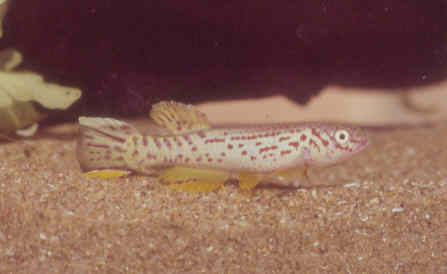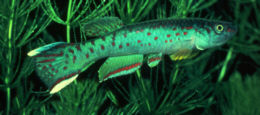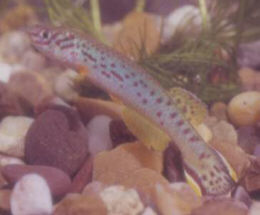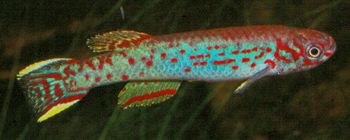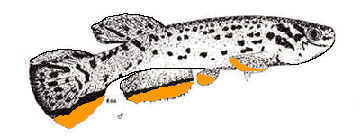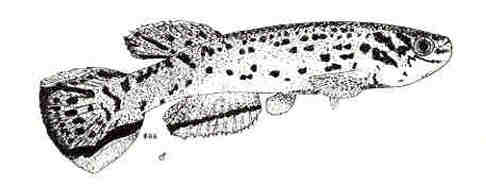Fundulopanchax scheeli (Radda 1970)
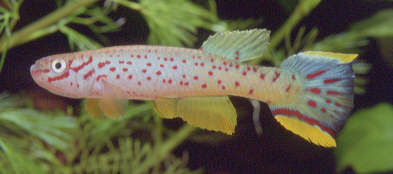
Fp.scheeli. Photo courtesy of Ed Pürzl.
| Meaning of Name |
After Jorgen Jacob Scheel. |
|||||||||
| First Description |
Radda A.C. 1970. Vorläufige Beschreibung von Aphyosemion scheeli nov. spec. Aquaria 17: p 177-180, figure. |
|||||||||
| Size |
6 cm |
|||||||||
| Meristics |
D = 10-12, A = 13-14, D/A = +4-5, ll = 31-32 (Radda 1970) |
|||||||||
| Karyotype |
n = 20, A = 38 (Scheel 1974) |
|||||||||
| Sub-Genus |
|
|||||||||
| Group |
oeseri |
|||||||||
| Synonyms |
* It is interesting to note that the true spelling of this village should be 'Akkamkpa'. See BKA newsletter No.154, June 1978. |
|||||||||
| Populations
|
Akkamkpa - Formerly described as a subsp.
(A.scheeli akamkpaensis). Known
to be in circulation in the BKA in 1978 & possibly earlier. |
|||||||||
| Type Locality |
Described from aquarium specimens. The exact wild origin is unknown. |
|||||||||
| Distribution |
A fairly small area of distribution east of the lower Cross River., southeastern Nigeria. |
|||||||||
| Habitat |
Found in small coastal rainforest streams & brooks, also in forested savannah where water flows over basement rock. |
|||||||||
| Distinguishing Characteristics |
|
|||||||||
| Colour/Pattern Variability | Fairly low | |||||||||
| History |
In Germany & Austria they appeared in 1964
as Aphyosemion burundi. The name
burundi was a mystery as this is
an area in east Africa well outside the distribution area for the genera
Aphyosemion &
Fundulopanchax.
A provisional description showing the relationship between scheeli,Burundi, gardneri & calliurum appeared in BKA newsletter No.81, May 1972 some 18 months after the original description in 'Aquaria' in 1970. An article appeared in the BKA newsletter No.
113, January 1975 by C.Turner which helped to confuse vexillifer
& 'Burundi' & probably led to both sp. being regarded as one
& the same. The article states-' Wildekamp collected A.scheeli
& the then A.scheeli akamkpaense
in the same tributary of the Cross River east of the village of Okporo
in 1990. As these fish were found syntopically (together) & given
the fact that the subspecies A.scheeli akamkpaense
was described on minor colouration differences it was felt that this
name was a synonym for A.scheeli. |
|||||||||
| Breeding Notes |
An easy species to breed laying eggs in top & bottom mops. Water incubation takes around 14 days. Growth rate is fairly fast with sexual maturity being reached about 4-5 months. Francis Bruhier in BKA Newsletter No.385, October 1997 reported using light green mops to good effect. Eggs are laid at the top of the mop. Eggs are placed on peat fibre & stored at 18 - 20°C. Wet eggs every month. Growth of young is rapid with sexing out at 3-4 months. |
|||||||||
| Diameter of Egg | 1·12 - 1·5 mm (Francis Bruhier) | |||||||||
| Remarks |
I had this species in the early 1970's as Aphyosemion 'burundi'. The colour photograph on page 140 of 'Rivulins of the Old World' Vol I (Scheel 1968) is in my opinion very close to the actual colours of this fish as maintained in those days. I also maintained the then A.scheeli akamkpaense which I found easy to breed. This population had a greenish background colouration on the body. |
